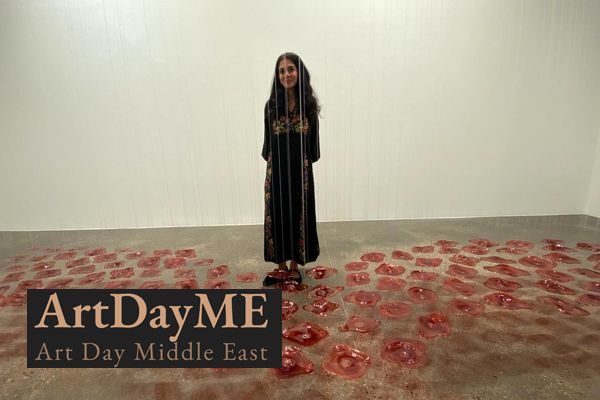Lawrie Shabibi | Dima Srouji | Alserkal Avenue
Dima Srouji's 'Charts for a Resurrection' at Lawrie Shabibi Gallery Dubai
Dubai's Lawrie Shabibi gallery is currently hosting an exhibition that transcends traditional artistic boundaries, inviting visitors on a poignant journey through history and memory in Palestine. Titled "Charts for a Resurrection," the exhibition showcases the visionary work of Dima Srouji, an architect and visual artist whose multidisciplinary approach offers a profound exploration of cultural heritage and collective repair.
ArtDayMe: Azadeh Jafarian: At the heart of Srouji's exhibition lies a unique blend of historical artifacts and imaginative reconstructions of archaeological sites. Through mediums such as stone-carved windows with colored glass inlays and suspended hand-blown glass sculptures, Srouji invites viewers to envision future archaeological monuments in the Palestinian landscape while reflecting on the region's rich cultural tapestry.
One of the exhibition's striking features is a nine-square grid wall installation, reminiscent of archaeological excavation sites. Here, partially excavated glass vessels serve as replicas of the original grave goods, shedding light on the complex narratives of displacement and ownership that permeate Palestinian history. Srouji pays homage to the often-overlooked contributions of Palestinian women, known as "basket girls," who were integral to these excavations yet marginalized by Western institutions.
In a more intimate space evocative of a chapel, Srouji's artwork takes on a deeply contemplative tone. Floating replicas of archaeological vessels, historically used as gifts to the deceased, serve as poignant reminders of loss and resilience amidst the ongoing tragedy in Palestine. Here, the chapel becomes a sanctuary for mourning and meditation, offering a space for healing and envisioning the future of a liberated Palestine through fictional archaeological artifacts.
Srouji's work extends beyond the confines of the gallery, engaging with audiences on a global scale. As the Jameel Fellow at the Victoria & Albert Museum and leader of Studio Underground Palestine at the Royal College of Art in London, Srouji's influence reverberates throughout the art world. Her projects, developed in collaboration with archaeologists, anthropologists, and artisans, challenge conventional notions of cultural heritage and public space, particularly in the context of the Middle East.
With pieces featured in prestigious institutions such as the Stedelijk Museum Amsterdam and the Corning Museum of Glass, Srouji's impact is undeniable. Through her thoughtful exploration of history, memory, and collective identity, she invites us to reconsider our understanding of the past while inspiring hope for the future.
As visitors navigate through "Charts for a Resurrection," they are invited to confront the complexities of Palestine's past and present, guided by Srouji's visionary artwork. In a world marked by division and discord, her exhibition serves as a powerful testament to the enduring power of art to bridge cultural divides and ignite conversations that transcend borders.































LEAVE A RELPY